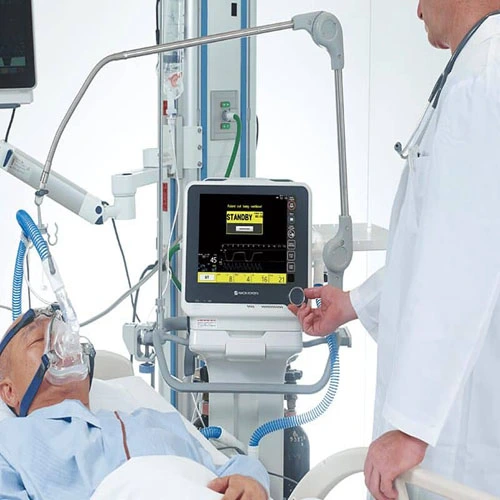- Home
- Departments
Departments Of Ventilator-Management
Ventilator-ManagementVentilator management is a critical aspect of caring for patients who require mechanical ventilation to support their respiratory function. It involves the careful selection, initiation, monitoring, and adjustment of ventilator settings to optimize oxygenation and ventilation while minimizing complications.
1. Indications for Mechanical Ventilation: Mechanical ventilation may be indicated for patients with acute respiratory failure due to various causes, including pneumonia, acute respiratory distress syndrome (ARDS), exacerbation of chronic obstructive pulmonary disease (COPD), pulmonary edema, sepsis, trauma, or neuromuscular disorders. The decision to initiate mechanical ventilation is based on clinical assessment, arterial blood gas analysis, and the severity of respiratory failure.
2. Ventilator Selection: Ventilators come in different modes and configurations, and the choice of ventilator depends on the patient's condition, the underlying pathology, and the desired ventilatory strategy. Common ventilator modes include assist-control ventilation, pressure support ventilation, synchronized intermittent mandatory ventilation, and pressure control ventilation. Ventilator settings such as tidal volume, respiratory rate, inspiratory time, positive end-expiratory pressure (PEEP), and fraction of inspired oxygen (FiO2) are adjusted based on the patient's needs and response to therapy.
3. Initiation of Mechanical Ventilation: Mechanical ventilation is initiated under the supervision of a trained healthcare provider, typically an intensivist, pulmonologist, or anesthesiologist. Ventilator settings are initially set based on the patient's respiratory mechanics, lung compliance, and severity of hypoxemia and hypercapnia. Careful attention is paid to prevent barotrauma, volutrauma, and ventilator-induced lung injury.
4. Monitoring and Assessment: Patients on mechanical ventilation are closely monitored to assess their response to therapy and detect complications. This includes monitoring vital signs, arterial blood gases, pulse oximetry, respiratory mechanics (such as plateau pressure and dynamic compliance), and ventilator waveforms. Regular assessments of lung function, oxygenation, and ventilation help guide adjustments to ventilator settings and optimize patient outcomes.
5. Optimizing Oxygenation and Ventilation: The primary goals of ventilator management are to optimize oxygenation and ventilation while minimizing ventilator-associated lung injury. This may involve adjusting FiO2, PEEP, and tidal volume to maintain adequate oxygenation and prevent atelectasis, while avoiding excessive tidal volumes and high airway pressures to minimize barotrauma and volutrauma.
6. Weaning and Liberation from Mechanical Ventilation: Weaning from mechanical ventilation involves gradually reducing ventilator support and assessing the patient's ability to breathe spontaneously. This may include spontaneous breathing trials, pressure support trials, or gradual reductions in ventilator support. Once the patient meets predefined criteria for successful extubation, such as adequate gas exchange, hemodynamic stability, and intact airway reflexes, the patient is liberated from mechanical ventilation.
7. Complications and Adverse Events: Ventilator management requires vigilant monitoring for complications and adverse events, including ventilator-associated pneumonia, barotrauma, volutrauma, pneumothorax, ventilator dyssynchrony, and sedation-related complications. Prompt recognition and management of these complications are essential for minimizing morbidity and mortality in mechanically ventilated patients.
Ventilator management is a complex and dynamic process that requires a thorough understanding of respiratory physiology, ventilator mechanics, and critical care principles. By providing individualized care and close monitoring, healthcare providers aim to optimize outcomes and improve the prognosis of patients requiring mechanical ventilation.

